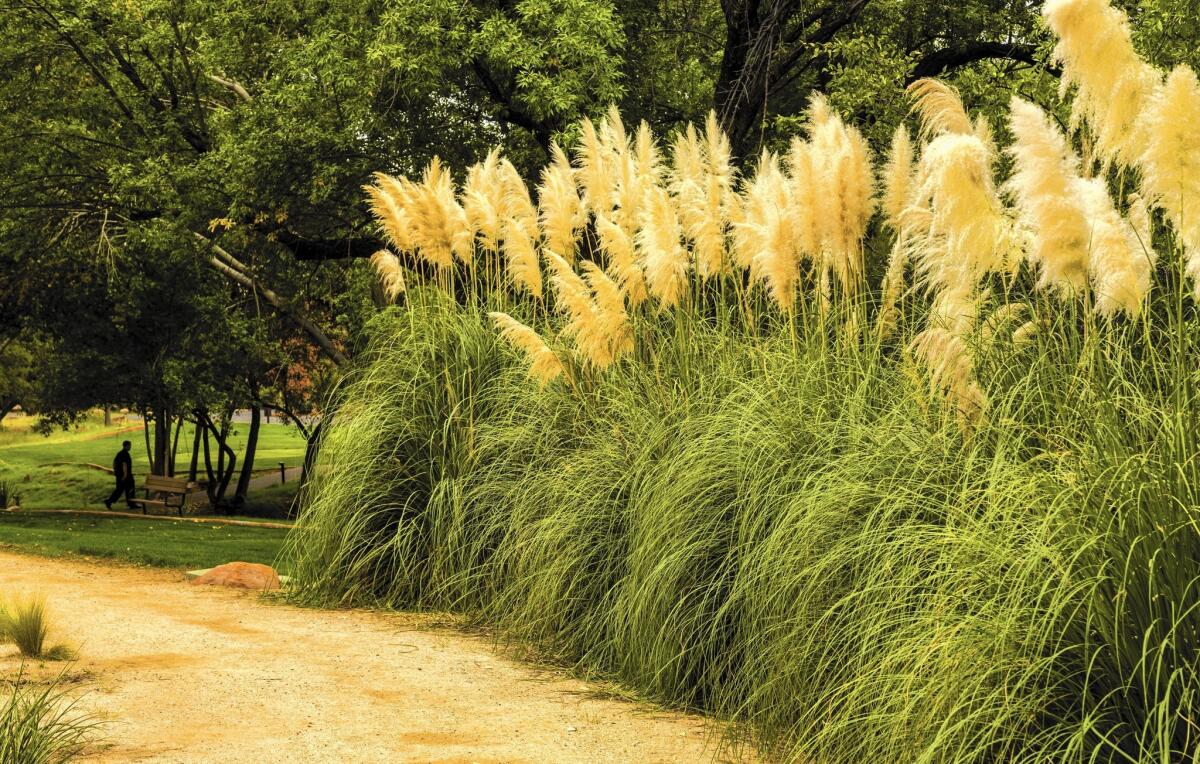Plant experts hope for a drought of invasives in ‘water-wise’ yards

- Share via
Many Californians appear to be taking up Gov. Jerry Brown’s call for the removal of 50 million square feet of lawn energetically and enthusiastically. But all that energy may be misplaced: As homeowners and businesses seek out drought-tolerant, low-water plants at local nurseries and big-box garden departments, they may unwittingly be picking up invasive plants that wreak havoc on the state’s ecology.
An invasive plant, according to the 1999 federal executive order defining it, is “a non-native that does or has potential to do harm to ecology, economy, or to human health.” Currently, 183 plants now in California fit that description, according to the California Department of Food and Agriculture.
------------
FOR THE RECORD
An earlier version of this post included a photograph of native bentgrass. It is not an invasive. It is a drought tolerant turf alternative.
------------
Invasives come in all shapes and sizes, such as the ubiquitous highway ice plant (Carpobrotus edulis) and certain types of seeding tall grasses, such as pampas grass, (Cortaderia selloana). They become invasive not only because they out-compete native plants, self-seeding with abandon, but also because they are tougher than nails and can withstand all sorts of bad conditions, including — and here’s the issue — drought.
The other problem is that many, if not most, are exceptionally nice-looking plants, the kind an unsuspecting customer would happily take home. “Ah, the unwise water-wise,” clucks Jan Merryweather of PlantRight, the nonprofit organization that works with growers and retailers to curtail the sale of invasive plants throughout the state. “It’s beautiful. It’s drought tolerant. What’s not to love about it, right?”
Plenty, as it turns out. That particular ice plant, once the ground cover of choice along roads and freeways and hillsides, has happily sprawled across dune habitats of nesters such as the plover, making it impossible for them to lay their eggs. The state is overrun with the dramatic tall stands of hot-burning plumed pampas grass, whose sharp leaves are inhospitable for food or shelter, and which quickly crowd out everything else, creating a monoculture that limits biodiversity. Some invasives release their own poisons to kill surrounding natives. Some can kill livestock that cannot digest them. Many clog waterways.
While consciousness is being raised through organizations such as the California Invasive Plant Council (Cal-IPC) and PlantRight, confusion still abounds. Cal-IPC Executive Director Doug Johnson recalls receiving an email one day from a frustrated local volunteer naturalist as Mayor Eric Garcetti was preparing to go on television to talk about drought-tolerant landscaping using her neighbor’s yard as a “laudatory” example. “It was filled with pampas grass and Mexican feather grass,” both rapidly rising invasive threats, Johnson says. “I could hear the anguish in her tone.”
Indeed, as cities, counties and water districts put together helpful drought-tolerant plant lists for consumers, invasives such as the feather grass will sometimes be included, and the municipalities themselves will plant them. Education, with a consistent message, is clearly called for, Johnson says, and it’s coming, just slowly. “My vision would be that there is a well-coordinated system that streamlines communication between the information sources, such as the universities and the [nongovernmental organizations] that are up on this, the nurseries and the consumers,” he says. “We’re in the messy middle of that process.”
More than half of California’s invasive plants were introduced through the state’s horticulture industry, generally without knowledge of the problems certain plants could pose down the line. Growers, of course, are responding to retailers. So it was something of a coup, then, when PlantRight recently announced a partnership with the Home Depot: In California, the chain will stop selling invasives. It was a deal three years in the making and similar to one reached with Armstrong Garden Centers.
“We had not been selling many invasives and had phased out one already,” says Brian Parker, senior manager of live goods for the Home Depot’s western division. He notes that, in the last four years or so, the chain has seen “major shifts” in garden products that customers request, with “double-digit” increases in the demand for succulents and grasses. As to invasives, “the big one on the shelf for us was the Mexican feather grass,” Parker says. “We have started the process of moving away from that item.”
“My responsibility is to not put invasives into the stores,” Parker adds. “Then we don’t have a problem.”
::
Some invasive plants to avoid in Southern California
Invasive plants are a growing issue as Southern Californians look to save water. Here are some common ones to put on your do-not-plant list.
Mexican feather grass (Nassella/Stipa tenuissima)
Periwinkle (Vinca major)
Green fountain grass (Pennesetum setaceum)
Scotch broom (Cytisus scoparius)
French broom (Genista monspessulana)
Pampas grass (Cortaderia selloana)
Highway ice plant (Carpobrotus edulis)
Water hyacinth (Eichhornia crassipes)
Yellow flag iris (Iris pseudacorus)
Source: PlantRight






